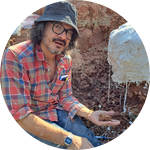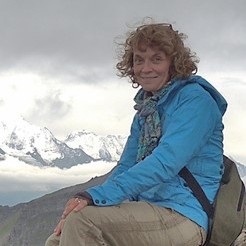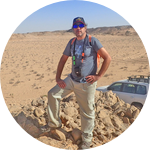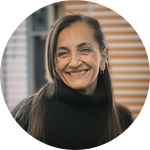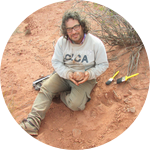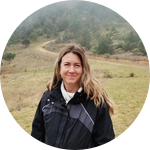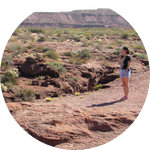About This Project
We need to use drones and 3D modeling to study ancient tracksites from the Eocene and Miocene (56–33.9 million years ago) and Miocene (23–5.3 million years ago), critical periods in the evolution of South American wildlife. These fossils reveal how birds and mammals adapted to environmental changes over millions of years. We'll also film the expedition in 360° VR, so anyone can experience real science in action.
Support us and be part of real science in action!
Ask the Scientists
Join The DiscussionWhat is the context of this research?
This project builds on years of research in northwestern Argentina, where fossil tracks provide a rare record of faunal evolution after the extinction of the dinosaurs. Sites like Vinchina and Quebrada de Santo Domingo creek preserve footprints from the Eocene and Miocene, periods of rapid faunal diversification in birds and mammals. Our team has already studied isolated tracks (birds, turtles and mammals), but large, continuous outcrops remain unexplored. Inspired by the potential of ichnology to reveal ancient behaviors and ecological habitats, we aim to map and analyze these key fossil surfaces to better understand how ancient animals lived, moved, and responded to changing environments.
What is the significance of this project?
Footprints are more than just fossils—they are behavioral snapshots and powerful paleobiological proxies, revealing the composition and dynamics of extinct ecosystems. By studying these large-scale trackway deposits containing extensive footprint assemblages, we can produce high-resolution maps and 3D models that preserve them digitally, aiding both research and education. This immediately benefits the scientific community by:
Resolving debates about post-dinosaur faunal turnover (e.g., how mammal/bird communities reorganized after the K-Pg extinction —the event that occurred 66 million years ago and wiped out the dinosaurs—).
Creating an open-access digital archive, preserving irreplaceable data.
Enabling education through interactive models, making deep-time ecosystems tangible for students and the public.
These footprints complement South America’s fossil record, offering new insights into vertebrate evolution and broader faunal shifts across deep time.
What are the goals of the project?
Our goal is to map and analyze tracksites from the Eocene and Miocene in Vinchina and Quebrada de Santo Domingo creek using drone-based photogrammetry.
We’ll conduct morphometric surveys with GPS and non-invasive methods, generating 3D models (point clouds, meshes, textures) via Agisoft Photoscan. Morphometric analysis will be performed in Geomagic Design X (3D) and ImageJ (2D). At each site, we’ll apply ecological diversity indices (Shannon-Weaver, Simpson, Fisher’s alpha, evenness) based on inferred trackmakers and life habits. Similarity across time will be assessed with the Jaccard index.
Simultaneously, we’ll film immersive 360° VR footage of the expedition to engage global audiences. Data will be openly shared, with scientific results submitted to peer-reviewed journals (e.g. Historical Biology), and VR content made freely available (e.g. YouTube). The October campaign is fully funded—your support covers the documentation tools and editing.
Budget
Each budget item is crucial for completing the research and outreach goals:
-
The drone allows efficient mapping of large and remote fossil sites in La Rioja, producing high-resolution images and 3D models that improve scientific documentation and preservation. Without it, site mapping would be slow and less accurate.
The 360º camera captures immersive VR videos of our fieldwork, fossil discoveries, and camp life. This technology helps engage a broader public by showing the real process of paleontological research.
-
Professional video editing ensures high-quality, accessible VR content with sound, subtitles, and smooth visuals, making the science understandable and attractive.
Together, these tools enhance our ability to conduct advanced research and share it effectively with the public, maximizing the project’s scientific and educational impact.
Endorsed by
 Project Timeline
Project Timeline
The project will run from August 2025 to December 2025. It includes crowdfunding campaign, field trip preparation, drone and 360º camera acquisition, fieldwork in October, and post-production of VR content. Final outputs will include immersive outreach videos and detailed 3D models of fossil tracksites in La Rioja, Argentina.
Jun 24, 2025
Project Launched
Aug 29, 2025
Equipment purchase and logistics coordination
Sep 12, 2025
Drone training and testing; finalize VR content strategy and outreach plan
Oct 03, 2025
Field protocols and equipment tests; prepare templates for lab notes
Oct 10, 2025
Field expedition to La Rioja starts
Meet the Team
Affiliates
Affiliates
Team Bio
We are the Ichnology Group of the Vertebrate Paleontology Lab (UBA–CONICET), dedicated to the study of fossil footprints across Argentina. Our work combines field expeditions in remote areas with detailed sedimentological and ichnological analysis, within a multidisciplinary approach that includes paleontology, geology, and biology.
Martin Ezequiel Farina
I’m a paleontologist and a PhD candidate in Biological Sciences at the Instituto de Estudios Andinos "Don Pablo Groeber" (UBA-CONICET) in Argentina. My research focuses on fossil bird footprints preserved in extreme landscapes in Argentina. By studying these ancient tracks, I aim to reconstruct past ecosystems and better understand how they changed over time.
Beyond research, I’m also a passionate science communicator. I write for national media, appear on national TV, and teach in the Evolution area at the University of Buenos Aires (UBA), as well as science communication at the University of Antofagasta (Chile). I believe in making science accessible, honest, and engaging—bringing knowledge closer to people who might not otherwise encounter it.
With this project, I hope to bring cutting-edge technology to fossil exploration in remote areas—and to share every step of that journey with those who are curious about how we uncover the natural history of our planet.
Verónica Krapovickas
I am a paleontologist specializing in the study of animal-sediment interactions as a window into the deep-time dynamics of ecosystems. My research focuses on how vertebrates interacted with their environments, particularly through the lens of fossil trackways, to understand how ecosystem structure and function have responded to major events in Earth's history. I am especially interested in the behavioral and ecological insights that can be drawn from ichnological records and how these contribute to reconstructing past landscapes and biotic communities.
Rocío Vera
I’m a paleontologist with a main focus on the study of extinct South American native ungulates from the Cenozoic, especially through the analysis of their fossil footprints. My research explores how these animals moved, interacted socially, and adapted to their environments, as well as how sedimentary conditions relate to their behavior and ecology. While my primary interest is in ungulates, I also work with footprints of other mammals that inhabited what is now Argentina. I love fieldwork, fossil excavation and preparation, and enjoy sharing paleontology through outreach in various educational settings, and contribute to science through paleoartistic reconstructions.
Project Backers
- 21Backers
- 16%Funded
- $390Total Donations
- $18.57Average Donation
